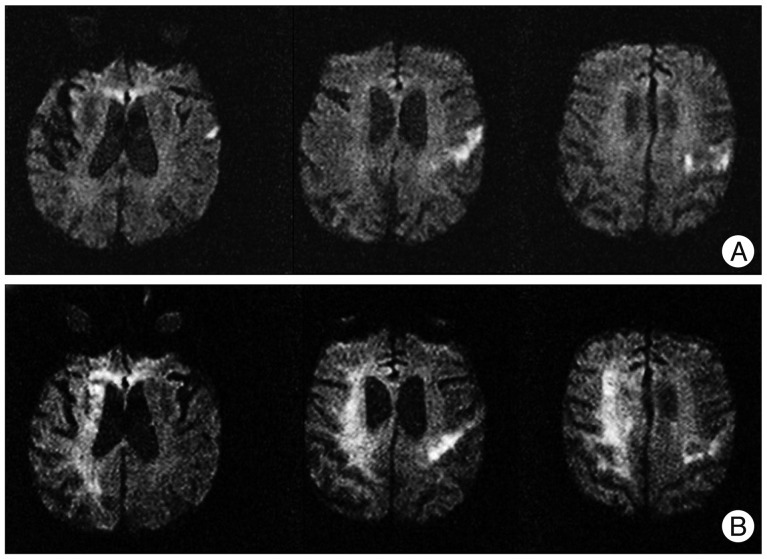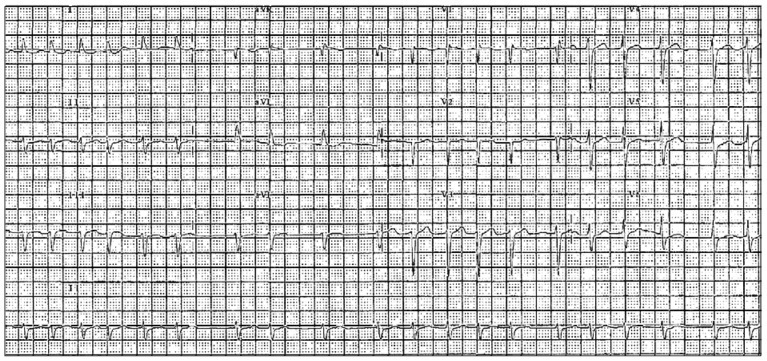J Korean Neurosurg Soc.
2013 Jun;53(6):368-370. 10.3340/jkns.2013.53.6.368.
Spontaneous Conversion of Atrial Fibrillation to Normal Sinus Rhythm Following Recurrent Cerebral Infarctions
- Affiliations
-
- 1Department of Neurology, Korea University Medical Center, Korea University College of Medicine, Seoul, Korea. nukbj@korea.ac.kr
- KMID: 2190826
- DOI: http://doi.org/10.3340/jkns.2013.53.6.368
Abstract
- Post-stroke atrial fibrillation has been frequently reported especially in the patients with right insular infarct as an evidence of cerebrogenic mechanism affecting on cardiac rhythm. However, conversion to normal sinus rhythm after stroke in patients who had atrial fibrillation has not been reported. A 88-year-old men who had untreated atrial fibrillation was admitted to hospital due to left middle cerebral artery territory infarction. During admission, second ischemic attack occurred in right middle cerebral artery territory. At that time, his atrial fibrillation converted spontaneously to normal sinus rhythm. Restored sinus rhythm sustained until he died due to sepsis. This case is evidence supporting a theory that brain is associated with control of cardiac rhythm. If no risk factor is revealed by intensive investigation in patients with acute cerebral infarctions that cardioembolism is strongly suspected as a cause, physicians should concern transformation of atrial fibrillation to normal sinus rhythm after stroke.
MeSH Terms
Figure
Reference
-
1. Cardiac and cardiovascular findings in patients with nervous system disease. In : Caplan LR, Hurst JW, Chimowitz MI, editors. Clinical Neurocardiology. New York: Marcel Dekker, Inc.;1999. p. 298–312.2. Cheung RT, Hachinski V. The insula and cerebrogenic sudden death. Arch Neurol. 2000; 57:1685–1688. PMID: 11115233.
Article3. Colivicchi F, Bassi A, Santini M, Caltagirone C. Cardiac autonomic derangement and arrhythmias in right-sided stroke with insular involvement. Stroke. 2004; 35:2094–2098. PMID: 15272134.
Article4. Colivicchi F, Bassi A, Santini M, Caltagirone C. Prognostic implications of right-sided insular damage, cardiac autonomic derangement, and arrhythmias after acute ischemic stroke. Stroke. 2005; 36:1710–1715. PMID: 16020766.
Article5. Di Pasquale G, Pinelli G, Andreoli A, Manini G, Grazi P, Tognetti F. Holter detection of cardiac arrhythmias in intracranial subarachnoid hemorrhage. Am J Cardiol. 1987; 59:596–600. PMID: 3825900.
Article6. Hachinski VC, Oppenheimer SM, Wilson JX, Guiraudon C, Cechetto DF. Asymmetry of sympathetic consequences of experimental stroke. Arch Neurol. 1992; 49:697–702. PMID: 1497495.
Article7. Kim D, Chung JW, Kim CK, Ryu WS, Park ES, Lee SH, et al. Impact of CHADS(2) Score on Neurological Severity and Long-Term Outcome in Atrial Fibrillation-Related Ischemic Stroke. J Clin Neurol. 2012; 8:251–258. PMID: 23323132.
Article8. Korpelainen JT, Huikuri HV, Sotaniemi KA, Myllylä VV. Abnormal heart rate variability reflecting autonomic dysfunction in brainstem infarction. Acta Neurol Scand. 1996; 94:337–342. PMID: 8947286.
Article9. Korpelainen JT, Sotaniemi KA, Huikuri HV, Myllyä VV. Abnormal heart rate variability as a manifestation of autonomic dysfunction in hemispheric brain infarction. Stroke. 1996; 27:2059–2063. PMID: 8898816.
Article10. Korpelainen JT, Sotaniemi KA, Mäkikallio A, Huikuri HV, Myllylä VV. Dynamic behavior of heart rate in ischemic stroke. Stroke. 1999; 30:1008–1013. PMID: 10229736.
Article11. Korpelainen JT, Sotaniemi KA, Suominen K, Tolonen U, Myllylä VV. Cardiovascular autonomic reflexes in brain infarction. Stroke. 1994; 25:787–792. PMID: 8160222.
Article12. Lane RD, Wallace JD, Petrosky PP, Schwartz GE, Gradman AH. Supraventricular tachycardia in patients with right hemisphere strokes. Stroke. 1992; 23:362–366. PMID: 1542897.
Article13. Low PA, Tomalia VA, Park KJ. Autonomic function tests : some clinical applications. J Clin Neurol. 2013; 9:1–8. PMID: 23346153.
Article14. Meyer S, Strittmatter M, Fischer C, Georg T, Schmitz B. Lateralization in autonomic dysfunction in ischemic stroke involving the insular cortex. Neuroreport. 2004; 15:357–361. PMID: 15076768.
Article15. Naver HK, Blomstrand C, Wallin BG. Reduced heart rate variability after right-sided stroke. Stroke. 1996; 27:247–251. PMID: 8571418.
Article16. Oppenheimer SM, Cechetto DF, Hachinski VC. Cerebrogenic cardiac arrhythmias. Cerebral electrocardiographic influences and their role in sudden death. Arch Neurol. 1990; 47:513–519. PMID: 2185720.17. Oppenheimer SM, Gelb A, Girvin JP, Hachinski VC. Cardiovascular effects of human insular cortex stimulation. Neurology. 1992; 42:1727–1732. PMID: 1513461.
Article18. Oppenheimer SM, Hachinski VC. The cardiac consequences of stroke. Neurol Clin. 1992; 10:167–176. PMID: 1557001.
Article19. Oppenheimer SM, Lima J. Neurology and the heart. J Neurol Neurosurg Psychiatry. 1998; 64:289–297. PMID: 9527137.
Article20. Sander D, Klingelhöfer J. Changes of circadian blood pressure patterns and cardiovascular parameters indicate lateralization of sympathetic activation following hemispheric brain infarction. J Neurol. 1995; 242:313–318. PMID: 7643140.
Article21. Takashima S, Nakagawa K, Hirai T, Dougu N, Taguchi Y, Sasahara E, et al. Transesophageal echocardiographic findings are independent and relevant predictors of ischemic stroke in patients with nonvalvular atrial fibrillation. J Clin Neurol. 2012; 8:170–176. PMID: 23091525.
Article22. Tokgözoglu SL, Batur MK, Top uoglu MA, Saribas O, Kes S, Oto A. Effects of stroke localization on cardiac autonomic balance and sudden death. Stroke. 1999; 30:1307–1311. PMID: 10390300.
Article23. Vingerhoets F, Bogousslavsky J, Regli F, Van Melle G. Atrial fibrillation after acute stroke. Stroke. 1993; 24:26–30. PMID: 8418546.
Article
- Full Text Links
- Actions
-
Cited
- CITED
-
- Close
- Share
- Similar articles
-
- Electrophysiologic Characteristics in the Process of Conversion from Atrial Fibrillation to Atrial Flutter
- Mid-term Result of Operations for Atrial Fibrillation
- The Mechanism of and Preventive Therapy for Stroke in Patients with Atrial Fibrillation
- Atrial Fibrillation in Patients with Hyperthyroidism
- A Clinical Analysis on the Restoration of Sinus Rhythm Following Mitral Valve Surgery




